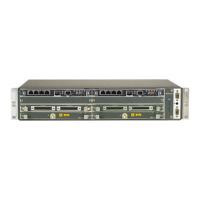User Manual
Product information and planning
9500 MPR Rel. 3.1
3DB18809AAAA Issue 1190/980
2.8.18 Ethernet Traffic Management
The Ethernet traffic is all the traffic entered the MPR network from user Ethernet ports.
By ECT/NMS it is possible to define the way to manage the Ethernet traffic according to one of the
following options:
– 802.1D (MAC Address bridge)
– 802.1Q (Virtual Bridge).
2.8.18.1 Bridge type change
In case of change of the bridge type from 802.1Q to 802.1D, the content of the VLAN table and the VLAN
assigned to the user Ethernet ports (refer to par.
2.8.18.2) has to be deleted by the Operator before to
change the bridge type.
2.8.18.2 Reserved Multicast Addresses
The following table summarizes the actions taken for specific reserved multicast addresses. Frames
identified with these destination addresses are handled uniquely since they are designed for Layer 2
Control Protocols.
The actions taken by the system can be:
– Discard - The system discards all ingress Ethernet frames and must not generate any egress Ether-
net Frame carrying the reserved multicast address.
– Forward - The system accepts all ingress Ethernet frames as standard multicast frames and for-
wards them accordingly.
– Peer - The system acts as a peer of the connected device in the operation of the relevant Layer 2
Control Protocol.
Reserved Multicast
Address
Function Action
01-80-C2-00-00-00 Bridge Group Address Forward
01-80-C2-00-00-01 Clause 31 (MAC Control) of IEEE 802.3 Flow-Control enabled: Peer
Flow-Control disabled: Discard
01-80-C2-00-00-02 Clause 43 (Link Aggregation) and Clause 57
(OAM) of IEEE 802.3
Peer for Link Aggregation and
ESMC
Discard for QAM
01-80-C2-00-00-03 IEEE 802.1X PAE address Discard
01-80-C2-00-00-04 -
01-80-C2-00-00-0D
Reserved for future standardization Discard
01-80-C2-00-00-0E IEEE 802.1AB LLDP multicast address Discard
01-80-C2-00-00-0F Reserved for future standardization Discard

